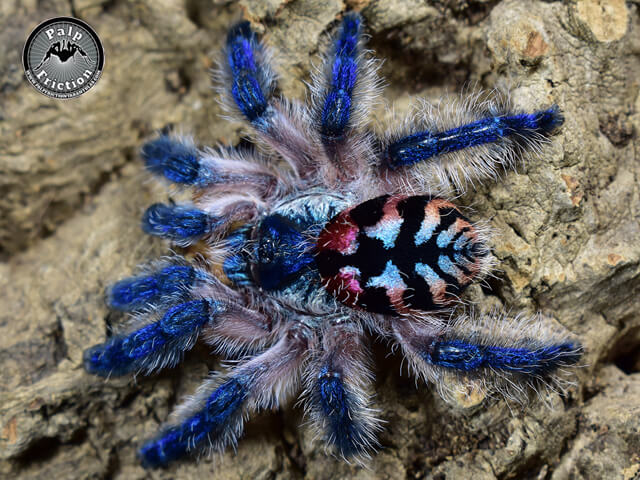
Brazilian Jewel Tarantula (Typhochlaena seladonia)
14. Digestive System
The Brazilian Jewel’s mouth is located on the front lower part of the prosoma and right underneath the chelicare.
In line with the tarantula’s small size, the mouth is short and designed to only suck. As such, its prey must be liquidized before the giant spider digs into the feast.
In the wild, this tarantula opts to crush and predigest chunkier foods to make digestion easier.
In captivity, extracting juices from the chelicerae and spraying them on the prey can also help the tarantula digest them.
The tarantula’s stomach runs the entire length of the arachnid’s body. The tube widens in the prosoma and acts as the sucking stomach.
When the muscles of the sucking stomach contract, the size of the stomach increases. This action causes a powerful sucking mechanism, enabling the tarantula to drink its liquid or semi-solid prey.
When the food enters the intestines, the usual process of assimilation and distribution takes place. The food then passes through the intestine walls into the bloodstream for distribution.
15. Health Concerns
Jewel Toe spiders are generally healthy species with few genetic concerns.
As long as the conditions in their enclosure are healthy, the species can live out its entire lifespan even in captivity.
Pet T. seladonia are, however, prone to dehydration. Enough water should be provided when the species is held in captivity.
Without the materials and optimal conditions for creating trapdoors, the Candy Shop spider cannot hunt properly, resulting in death and malnutrition.
16. Optimal Environment
The Brazilian Jewel tarantula needs high levels of humidity ranging between 70 and 85%. In captivity, the enclosure should be properly ventilated.
This tarantula survives best in temperatures ranging between 26-30OC in summer and 20-24OC in winter.
17. Reproduction
A mature male species interested in mating will first rub its abdomen on a surface to release semen.
It then dips its shorter leg appendages into the semen. The appendages, also known as pedipalps, will retain the semen until the male can find a suitable mating partner.
When the male detects a female, they both exchange signals, communicating that they are of the same species.
If the female Brazilian Jewel tarantula is receptive, the male inserts his semen-soaked pedipalps into a pouch on the female’s abdomen.
The male usually leaves as soon as the process is completed. Although rare, some female T. seladonia end up eating up their male partners.
The females can lay up to 2000 eggs. They do so in a silk sac and protect it for 6-7 weeks.
The young Brazilian Jewel will stay in the nest for a while. Before dispersing and becoming independent, the young ones will eat the remainder of the yolk sac.
The Brazilian Jewel’s mouth is located on the front lower part of the prosoma and right underneath the chelicare.
In line with the tarantula’s small size, the mouth is short and designed to only suck. As such, its prey must be liquidized before the giant spider digs into the feast.
In the wild, this tarantula opts to crush and predigest chunkier foods to make digestion easier.
In captivity, extracting juices from the chelicerae and spraying them on the prey can also help the tarantula digest them.
The tarantula’s stomach runs the entire length of the arachnid’s body. The tube widens in the prosoma and acts as the sucking stomach.
When the muscles of the sucking stomach contract, the size of the stomach increases. This action causes a powerful sucking mechanism, enabling the tarantula to drink its liquid or semi-solid prey.
When the food enters the intestines, the usual process of assimilation and distribution takes place. The food then passes through the intestine walls into the bloodstream for distribution.
15. Health Concerns
Jewel Toe spiders are generally healthy species with few genetic concerns.
As long as the conditions in their enclosure are healthy, the species can live out its entire lifespan even in captivity.
Pet T. seladonia are, however, prone to dehydration. Enough water should be provided when the species is held in captivity.
Without the materials and optimal conditions for creating trapdoors, the Candy Shop spider cannot hunt properly, resulting in death and malnutrition.
16. Optimal Environment
The Brazilian Jewel tarantula needs high levels of humidity ranging between 70 and 85%. In captivity, the enclosure should be properly ventilated.
This tarantula survives best in temperatures ranging between 26-30OC in summer and 20-24OC in winter.
17. Reproduction
A mature male species interested in mating will first rub its abdomen on a surface to release semen.
It then dips its shorter leg appendages into the semen. The appendages, also known as pedipalps, will retain the semen until the male can find a suitable mating partner.
When the male detects a female, they both exchange signals, communicating that they are of the same species.
If the female Brazilian Jewel tarantula is receptive, the male inserts his semen-soaked pedipalps into a pouch on the female’s abdomen.
The male usually leaves as soon as the process is completed. Although rare, some female T. seladonia end up eating up their male partners.
The females can lay up to 2000 eggs. They do so in a silk sac and protect it for 6-7 weeks.
The young Brazilian Jewel will stay in the nest for a while. Before dispersing and becoming independent, the young ones will eat the remainder of the yolk sac.
Advertisements
20 December 2022
Advertisements



